Wildlife
A wildlife survey was undertaken of the churchyard on the 5th & 22nd of July and the results of that survey are presented here.
Birds
The majority of the bird records came from the woodland edge surrounding the churchyard and overflying birds. 19 species were recorded during the survey.
Two red status species and two amber status species were recorded during the survey:
(For information on the red and amber status lists go to the RSPB website.)
Herring Gull Larus argentatus (Red Status) – This species was only recorded flying over the churchyard area. Hastings & St Leonards support a major breeding population of this species which is undergoing a long-term breeding decline and Britain supports an internationally important breeding and non-breeding population of this species.
Song Thrush Turdus philomelos (Red Status) – A song thrush was recorded singing and feeding amongst the woodland edge surrounding the churchyard. This species is also undergoing a long term species decline and woodland edge habitat bordering grassland and gardens is very important for this species.
Swift Apus apus (Amber Status) – Recorded flying over the churchyard area. This species breeds in buildings in Hastings & St Leonards but is another species undergoing a population decline in Britain.
Bullfinch Pyrrhula pyrrhula (Amber Status) – A small flock of bullfinch were recorded using the woodland edge surrounding the churchyard. This may have been a family group that had bred nearby. This is another species that has undergone a significant population decline in Britain and requires species diverse woodland edge and scrub habitat to breed.
Species list of birds recorded during the survey.
- Herring Gull Larus argentatus
- Wood Pigeon Columba palumbus
- Swift Apus apus
- Wren Troglodytes troglodytes
- Robin Erithacus rubercula
- Song Thrush Turdus philomelos
- Blackbird Turdus merula
- Blackcap Sylvia atricapilla
- Chiffchaff Phylloscopus collybita
- Goldcrest Regulus regulus
- Great Tit Parus major
- Blue Tit Cyanistes caeruleus
- Long-tailed Tit Aegithalos caudatus
- Nuthatch Sitta europaea
- Treecreeper Certhia familiaris
- Magpie Pica pica
- Chaffinch Fringilla coelebs
- Greenfinch Carduelis chloris
- Bullfinch Pyrrhula pyrrhula
Old St Helen’s Church Survey 2012 – Bird Check List (.pdf)
Vascular Plants
During the survey 56 species of vascular plants were recorded. A small number of rare and scarce arable plants were recorded but as these were seeded rather naturally grown these records are not as important as if they had been recorded in the wild.
Species of scarce arable plants recorded included:
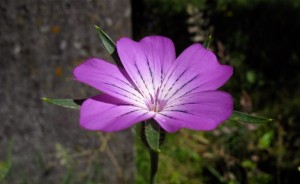
Corncockle Agrostemma githago. Nationally rare, almost extinct as a native but commonly introduced with wildflower seed mixes.
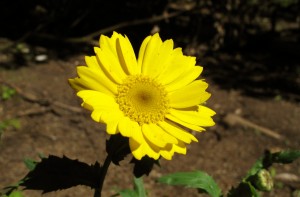
Corn Marigold Glebionis segetum. This species has a conservation status of Vulnerable and is declining in the wild, another species commonly introduced with wildflower seed mixes.
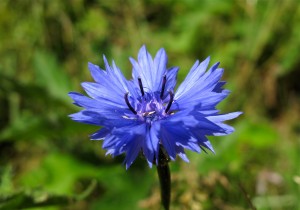
Cornflower Centaurea cyanus. This species is very rare in the wild and a UK Biodiversity Action Plan species due to it’s decline. Also commonly introduced with wildflower seed mixes.
Species list of vascular plants recorded during the survey. (Alphabetical order)
- Alsike Clover Trifolium hybridum
- Ash Fraxinus excelsior
- Borage Borago officinalis
- Bramble Rubus fruticosus agg.
- Broad-leaved Dock Rumex obtusifolius
- Broad-leaved Willowherb Epilobium lanceolatum
- Cleavers Galium aparine
- Cock’s-foot Dactylis glomerata
- Colt’s-foot Tussilago farfara
- Common Nettle Urtica dioica
- Common Poppy Papaver rhoeas
- Common Ragwort Jacobaea vulgaris
- Common Sorrel Rumex acetosa
- Corn Chamomile Anthemis arvensis
- Corn Marigold Glebionis segetum
- Corncockle Agrostemma githago
- Cornflower Centaurea cyanus
- Cow Parsley Anthriscus sylvestris
- Creeping Buttercup Ranunculus repens
- Crimson Clover Trifolium incarnatum
- Curled Dock Rumex crispus
- Daisy Bellis perennis
- Dandelion Taraxacum officinale
- Field Forget-me-not Myosotis arvensis
- Field Maple Acer campestre
- Garlic Mustard Alliaria petiolata
- Germander Speedwell Veronica chamaedrys
- Hairy Bittercress Cardamine hirsuta
- Hard Shield Fern Polystichum aculeatum
- Hedge Mustard Sisymbrium officinale
- Hedge Woundwort Stachys sylvatica
- Hedgerow Crane’s-bill Geranium pyrenaicum
- Herb-robert Geranium robertianum
- Hogweed Heracleum sphondylium
- Ivy Hedera helix
- Ivy-leaved Toadflax Cymbalaria muralis
- Japanese Knotweed Fallopia japonica
- Lathyrus sp.
- Long-stalked Crane’s-bill Geranium columbinum
- Meadow Crane’s-bill Geranium pratense
- Norway Maple Acer platanoides
- Pendulous Sedge Carex pendula
- Raspberry Rubus idaeus
- Red Campion Silene dioica
- Scarlet Pimpernel Anagallis arvensis
- Smooth Hawk’s-beard Crepis capillaris
- Smooth Meadow-grass Poa pratensis
- Smooth Sow-thistle Sonchus oleraceus
- Spear Thistle Cirsium vulgare
- Sycamore Acer pseudoplatanus
- Triticum sp.
- Tufted Vetch Vicia cracca
- White Clover Trifolium repens
- Wood Avens Geum urbanum
- Wood Dock Rumex sanguineus
- Yorkshire Fog Holcus lanatus
Old St Helen’s Church Wildlife Survey 2012 – Vascular Plant Check List (.pdf)
Insects
35 species of insect were recorded during the survey.
Odonata – Dragonflies & damselflies
1 species of Odonata was recorded during the survey.
Species list of Odonata recorded during the survey.
- Azure Damselfly Coenagrion puella
Orthoptera – Grasshoppers & Crickets
2 species of Orthoptera were recorded during the survey.
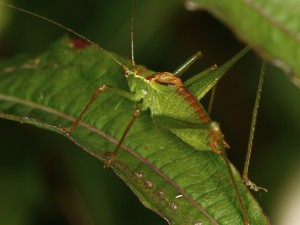
Speckled Bush-cricket.
Species list of Orthoptera recorded during the survey.
- Meadow Grasshopper Chorthippus parallelus
- Speckled Bush-cricket Leptophyes punctatissima
Dermaptera – Earwigs
1 species of Dermaptera was recorded during the survey.
Species list of Dermaptera recorded during the survey.
- Common Earwig Forficula auricularia
Hemiptera – True Bugs
6 species of Hemiptera were recorded during the survey.
Species list of Hemiptera recorded during the survey.
- Anthocoris nemorum
- Stenodema calcarata
- Tingis cardui
- Coreus marginatus
- Philaenus spumarius
- Aphrophora alni
Mecoptera – Scorpion-flies
1 species recorded during the survey.
- Panorpa communis
Lepidoptera – Butterflies & Moths
4 species recorded during the survey.
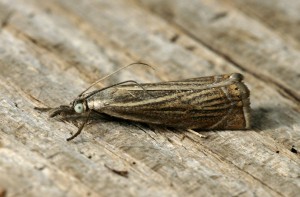
Chrysoteuchia culmella
Species list of Lepidoptera recorded during the survey.
- Chrysoteuchia culmella
- Large WhitePieris brassicae
- Meadow BrownManiola jurtina
- Red AdmiralVanessa atalanta
Diptera – Two-winged Flies
7 species recorded including one nationally rare species of hoverfly, Rhingia rostrata.
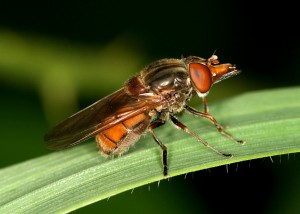
The above photo is of the much more common Rhingia campestris but the two species look very similar. The rarer Rhingia rostrata, which occurs at this site, has a shorter snout and lacks the black markings on the abdomen.
Rhingia rostrata currently has the conservation status IUCN (pre 1994) – Vulnerable, although this species has been increasing in range in recent years. This species is considered to breed in badger dung and badger latrines and probably occurs at the site due to the proximity of the large active badger sett in the surrounding woodland.
Species list of Diptera recorded during the survey.
- Episyrphus balteatus
- Sphaerophoria scripta
- Rhingia rostrata
- Cheilosia illustrata
- Xylota segnis
- Eristalis tenax
- Myathropa florea
Coleoptera – Beetles
4 species recorded during the survey.
Species list of Coleoptera recorded during the survey.
- Rhagonycha fulva
- Malachius bipustulatus
- Coccinella 7-punctata
- Oedemera nobilis
Hymenoptera- Bees, wasps & ants
9 species were recorded during the survey including the newly colonised tree bumblebee Bombus hypnorum.
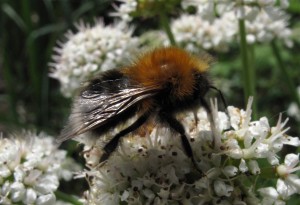
Bombus hypnorumTree Bumblebee.
This bumblebee, which breeds in holes in trees and within nest boxes was recorded as new to Britain in 2001 from Landford, Wilts. Marline Valley Nature Reserve, Hastings was one of the first places it was recorded in Sussex but it has been rarely recorded in Hastings since until this year. It is now clearly established and breeding in Hastings now. The species is unique for a British bumblebee in having the combination of a ginger thorax, a black abdomen and a white ‘tail’.
Species list of Hymenoptera recorded during the survey.
- Ectemnius continuus (nests in dead wood)
- Crossocerus megacephalus (nests in old beetle borings in dead wood)
- Hylaeus brevicornis (nests in bramble stems)
- Osmia rufa (nests in holes in mortar and crumbling walls)
- Bombus hypnorum
- Bombus pascuorum
- Bombus terrestris/lucorum
- Bombus hortorum
- Lasius niger
Spiders
8 species recorded during the survey including 2 nationally scarce species, Zilla diodia, which is a small orbweaver associated with woodland edge and scrub vegetation and Coelotes terrestris, which is found under stones and fallen logs.
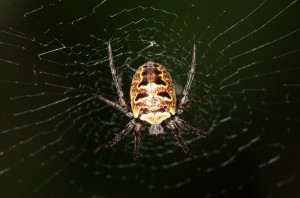
Zilla diodia.
Species list of Spiders recorded during the survey.
- Amaurobius ferox
- Amaurobius similis
- Coelotes terrestris
- Araneus diadematus
- Metellina mengei
- Theridion pallens
- Zilla diodia
- Zygiella x-notata
Mammals
No mammals were recorded during the survey except for the presence of a large badger sett in the woodland adjacent to the graveyard. This is clearly a very active sett, possibly a breeding sett.
